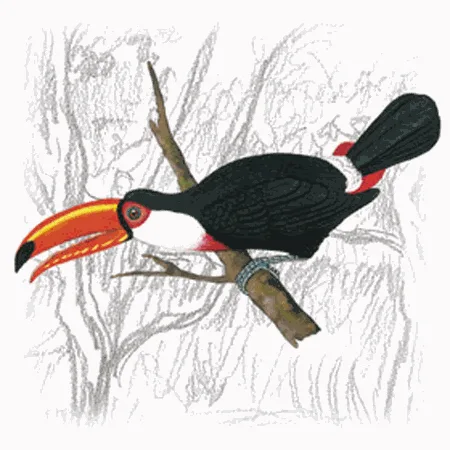
Toco Toucan
[order] PICIFORMES | [family] Ramphastidae | [latin] Ramphastos toco | [UK] Toco Toucan | [FR] Toucan toco | [DE] Riesentukan | [ES] Tucan Toco | [NL] Reuzentoekan
Subspecies
| Genus | Species | subspecies | Breeding Range | Breeding Range 2 | Non Breeding Range |
| Ramphastos | toco | SA | ne, c, se | ||
| Ramphastos | toco | albogularis | e and s Brazil, n Bolivia, Paraguay and n Argentina | ||
| Ramphastos | toco | toco | the Guianas, n and ne Brazil, se Peru |
Physical charateristics
The Toco Toucan has a mainly black body, a white throat, chest and uppertail-coverts, and red undertail-coverts. The iris is blue and surrounded by a ring of bare, orange skin. The most noticeable feature, however, is its huge bill, which is yellow-orange, tending to deeper reddish-orange on its lower sections and culmen, and with a black base and large spot on the tip. It looks heavy, but as in other toucans it is relatively light because the inside largely is hollow. The tongue is nearly as long as the bill and very flat. With a total length of 55-65 cm, incl. a bill that measure almost 20 cm. Males are larger than females, but otherwise the sexes are alike.
Listen to the sound of Toco Toucan
[audio:http://www.aviflevoland.nl/sounddb/T/Toco Toucan.mp3]
Copyright remark: Most sounds derived from xeno-canto
| wingspan min.: | 0 | cm | wingspan max.: | 0 | cm |
| size min.: | 55 | cm | size max.: | 61 | cm |
| incubation min.: | 17 | days | incubation max.: | 18 | days |
| fledging min.: | 43 | days | fledging max.: | 18 | days |
| broods: | 1 | eggs min.: | 2 | ||
| eggs max.: | 4 |
Range
South America : Northeast, Central, Southeast
Habitat
It is, unlike the other members of the genus Ramphastos, essentially is a non-forest species. It can be found in a wide range of semi-open habitats such as woodland, savanna and other open habitats with scattered trees, Cerrado, plantations, forest-edge and even wooded gardens. It is mainly a species of lowlands, but occurs up to 1750 m near the Andes in Bolivia. Due to its preference for open habitats it is likely to benefit from the widespread deforestation in tropical South America. It has a large range and except in the outer regions of its range, it typically is fairly common.
Reproduction
Nesting is seasonal, but timing differs between regions. The nest is typically placed high in a tree and consists of a cavity; at least part of which is excavated by the parent birds themselves. It has also been recorded nesting in holes in earth-bank and terrestrial termite-nests. The female usually lays 2 to 4 eggs a few days after mating. The eggs are incubated by both sexes and hatch after 17-18 days. Young fledge after 43-52 days, may have several broods a year (in captivity). First breeding not before the age of 2 or 3 years. Little is known about this species in the wild.
Feeding habits
The Toco Toucan eats mainly fruit and seeds using its bill to pluck them from trees, but also insects, lizards, nestlings and eggs of birds. The bill is used to skin fruit and scare off predators. It is typically seen in pairs or small family-groups. Feeds in canopy but will occasionally descend to ground level to forage, moves by hopping.
Conservation
This species has an extremely large range, and hence does not approach the thresholds for Vulnerable under the range size criterion (Extent of Occurrence <20,000 km2 combined with a declining or fluctuating range size, habitat extent/quality, or population size and a small number of locations or severe fragmentation). Despite the fact that the population trend appears to be decreasing, the decline is not believed to be sufficiently rapid to approach the thresholds for Vulnerable under the population trend criterion (>30% decline over ten years or three generations). The population size has not been quantified, but it is not believed to approach the thresholds for Vulnerable under the population size criterion (<10,000 mature individuals with a continuing decline estimated to be >10% in ten years or three generations, or with a specified population structure). For these reasons the species is evaluated as Least Concern.

Migration
Sedentary throughout range, but local movements known to occur.
Distribution map

